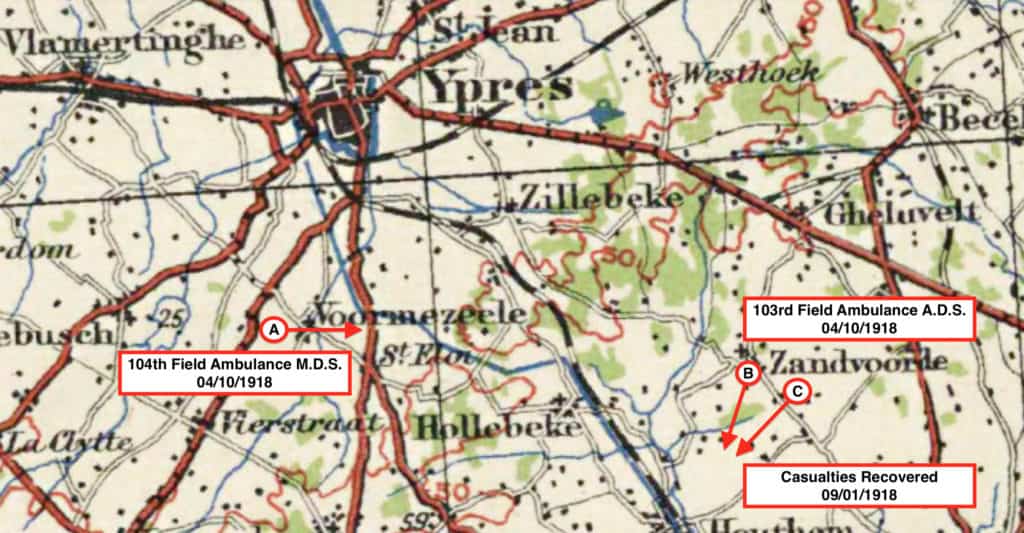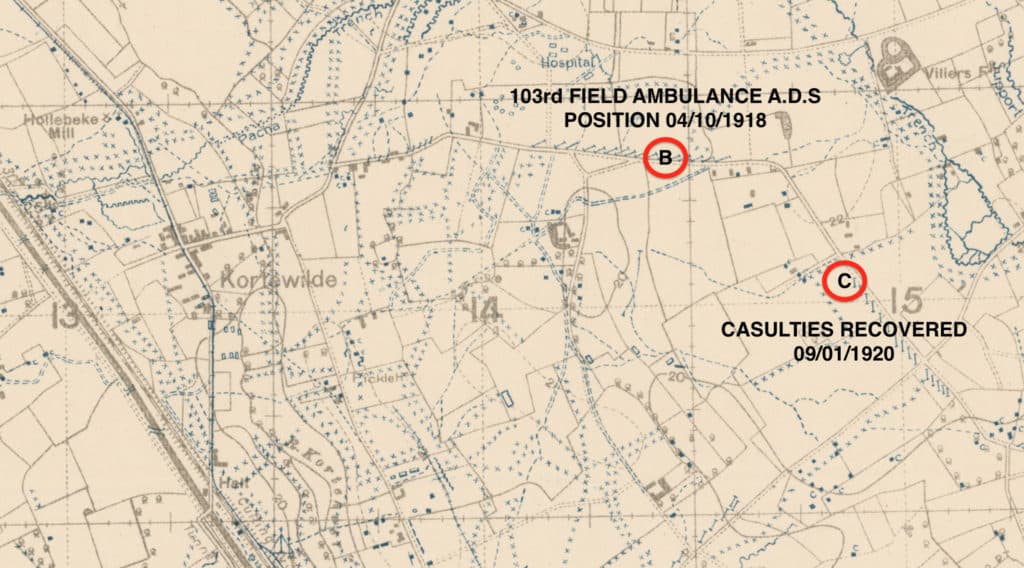Thank you to Lenka Cathersides for the following research. Thank you to Andy Bailey from Ewhurst Fallen for the military detail.
William Chandler was born in the 2nd quarter of 1897 in Ockley, Surrey to labourer William Henry and Sarah nee Brooker. He was baptised on the 20th of June 1897 at St Margaret’s Church, Ockley. At the time of his baptism, the family lived in Ockley, where his father, William was working as a labourer.
William’s father William was born in the 1st quarter of 1869 in Capel to brick burner Emanuel Chandler, born about 1841 in Capel and Sarah nee Mitchell, born about 1848 in Wotton, Surrey. His mother Sarah was born in the 4th quarter of 1873 in Effingham to farm labourer William Brooker, born about 1844 in Ewhurst and Sarah nee Lassam born about 1844 in Cranleigh, Surrey. William and Sarah married, by Banns, on the 2nd of November 1895 at St Lawrence’s Church in Effingham.
William had one known sibling: Edith Helena Chandler born about 1901 in Ockley. She later became Mrs Brown.
At the time of the 1901 Census, the family lived at Wolverstone Cottages, Ockley. William snr was working as a carter on a farm and Sarah was looking after their children: William and Edith
At the time of the 1911 Census, the family lived at Hatch Cottage, Station Road, Ockley. William snr was working as a wagoner on a farm and Sarah was at home looking after their children. Sarah stated that she had given birth to two children. The accommodation had five rooms.
William Chandler enlisted at the age of 19 on 24th August 1915 in Guildford, Surrey into the Royal Army Medical Corps. He was a Private with regimental number 65447. At the time of his enlistment he was living with his parents at Hatch Cottage and working as a motor driver.
His enlistment as a member of Lord Kitchener’s New Armies was on a Short Service term, for the Duration of the War, and William was assigned to 104th Field Ambulance of 34th Division. The Division had two further Field Ambulances providing medical support (‘Field Ambulance’ being the descriptive term for a mobile medical unit rather than a vehicle). The 34th Division comprised of many ‘pals battalions’ raised in the north east of England, and their basic training was undertaken in the North. In mid 1915 the Division was concentrated around Ripon in Yorkshire before moving south to Salisbury Plain for final training in late August 1915.
It is likely that William would have followed this geographic progression for his training. On 3rd January 1916, the Division received orders to embark for active service overseas, and by 15th January, the Division had crossed the Channel and was concentrated at La Crosse, east of St Omer.
William, with the 104th FA, marched out of their encampment at Sutton Veny in Wiltshire at 15 minutes past midnight on 8th January bound for the railway station at Amesbury, 19 miles away. The unit, 10 officers and 216 other ranks, paused for breakfast at 8am and divided into two details for embarkaction onto two trains at Amesbury. From there the trains carried them to Southampton, where they boarded two ships H.T. Viper and H.T. Australinda. The vessels crossed the Channel to Havre, disembarking the unit on 9th January and from where trains carried the men to the St Omer area to rejoin their Division.
William’s experience in the First World War would have mirrored that of the 34th Division, and as a member of the medical support of the Division he would have had to deal with both the sick and the wounded from any action that the Division participated in. Details of his later service hints that he acted as a stretcher bearer, assisting with the processing of casualties from the Regimental Aid Posts through the Advanced Dressing Stations to the Main Dressing Stations, staffed by the Division’s three Field Ambulances (102nd, 103rd and 104th).
The 34th Division took part in the following major actions, together with periods of ‘holding the line’:
- 1916
- Battle of the Somme
- 1917
- The Arras Offensive
- The Third Battle of Ypres
- 1918
- The Battle of the Lys
- The 1918 Battles of the Marne
- The Final Advance
The units of the 34th Division suffered heavy losses during the Battles of the Lys (7th-29th April 1918, fighting associated with the German Spring Offensive) following which the Division was withdrawn from fighting and reduced to cadre strength. In June and July it was reformed with many new units, but remained supported by its original Field Ambulances.
On 16th July, William and the men of the 34th Division were ordered to move south to the Marne area and placed under the command of the French Tenth Army. They arrived in the area on 21st July and were detailed to take part in an attack on the morning of the 23rd July, supporting French units. For most of the men of the reconstituted 34th Division this was to be their first experience on the battlefield, following a lengthly transit to the Marne. They were fighting in an unfamiliar military organisation and in an area that they had not had the opportunity to become familiar with.
The Division went into action at 7am on 23rd July near the village of Tigny, approximately 5km south of Soissons. The unit war diaries indicate that 104th Field Ambulance manned a Main Dressing Station (M.D.S.) whilst 103rd Field Ambulance provided an Advanced Dressing Station (A.D.S). These forward dressing stations acted as collection points for casualties being brought in from the battle by stretcher bearers provided by the Field Ambulance units, who collected them from relay points closer to the front line. Stretcher bearers like William Chandler could provide basic first aid to a casualty, and once they arrived at the Dressing stations they would receive further treatment and be put into a condition where they could be evacuated to a Casualty Clearing Station, or returned to their unit.
The previous day, one officer and 18 stretcher bearer squads of the 104th Field Ambulance were dispatched to 103rd Field Ambulance to assist with the collection of casualties in the forthcoming action. On 29th August 1918, Pte William Chandler, 65447, and Pte William George Elkins, 65630 (1), of 104th Field Ambulance were gazetted for Military Medals. It is likely, therefore, that these two men were part of the bearer squads assigned to 103rd Field Ambulance and that their Military Medal awards were for actions on or shortly after the 23rd July attack. The two men were to be killed together on 4th October 1918, and so it is quite probable that they were acting together as a stretcher bearer team during this period of the war.
- (1) Private William George Elkins, aged 20, was the son of Thomas and Augusta Elkins, of Mapletree Lane, Mill Green, Ingatestone, Essex and is commemorated on the Billericay War Memorial, Essex.
- (2) Private Thomas Leslie Hanslip, aged 22, was the son of Arthur and Priscilla Hanslip, of West Newton, King’s Lynn, Norfolk, and is commemorated on the Sandringham War Memorial and the West Newton Roll of Honour, Norfolk.
34th Division remained in the Marne area under French command until the end of August 1918, when it was returned to British command and moved back into the Ypres area. In September, William Chandler and the men of 104th Field Ambulance worked in the area around Remy Sidings, near Lijssenthoek. This was the location of Casualty Clearing Stations just beyond the range of enemy artillery and the railway sidings were used to assemble ambulance trains to move the casualties from the Ypres salient back to base hospitals. It is now also the location of one of the largest Commonwealth War Grave in the world, which indicates the sheer volume of work of the medical services in this location.


On 29th September 1918, 104th Field Ambulance was ordered to create an M.D.S. in the area east of Voormezele, south of Ypres (see location ‘A’ on map 1).
103rd Field Ambulance had moved to create an A.D.S east of Kortewilde (position ‘B’ on maps) on 2nd October 1919.

© National Archives

© National Archives
As the unit was understaffed, the unit war diaries note that 2 NCOs, 40 bearers and 3 Horse Ambulance Wagons of 104th Field Ambulance were forwarded to 103rd Field Ambulance Advance Dressing Station at grid reference P.14b.9.7 for duty. This detachment included William Chandler, William Elkins and Pte Thomas Hanslip (2). On 4th October the three men were killed by a bursting enemy shell, together with Pte Arthur Bathurst, 65472 (3) of 103rd Field Ambulance.

Zantvoorde British Cemetery
Roll of Honour © CWGC.org
All four men were buried together in a marked grave at map grid reference Sheet 28 P15 a 7.1, approximately 460m away from the location of the A.D.S. (see position C on the maps). Just 38 days of the First World War remained before the Armistice on 11th November 1918.
Their bodies were recovered from this location on 9th January 1920 and re-inturred together at Zantvoorde British Cemetery.
During the First World War, 15 members of the 104th Field Ambulance died overseas on active service. Whilst the unit was not a front line combat unit, its men were; never the less involved with dealing with the casualties from the front line, often under enemy fire. Their close co-operation with one another as stretcher bearers often meant that two or three men were lost on the same day, probably to the same shell. Like William Chandler and William Elkins a number were awarded bravery awards for their actions.
He received the British War and Victory medals and the Military Medal.
William’s father received £18, 8s and 7d on 26th April 1919 in Soldier’s Effects.
| Born | Ockley | |
| Lived | Ockley | |
| Son of | William Henry and Sarah Brooker of Hatch Cottage, Station Road, Ockley | |
| Regiment | 104th Field Ambulance, Royal Medical Army Corps | |
| Number | 65447 | |
| Date of Death | 4th October 1918 | |
| Place of Death | Belgium | |
| Cause of Death | Killed in action | |
| Age | 22 | |
| Cemetery | Zantvoorde British Cemetery, Belgium |

